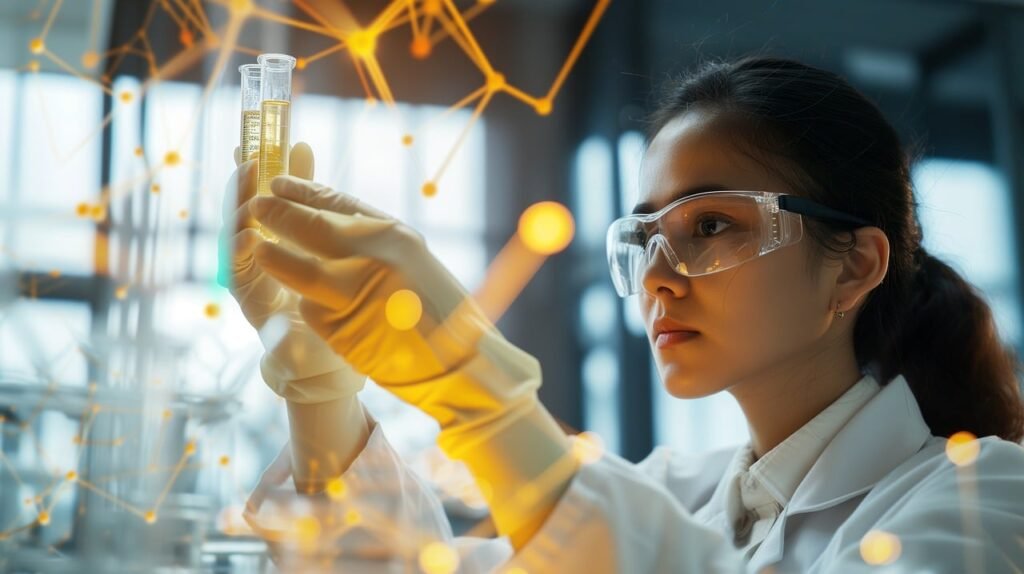Today, thanks to advancements in science and technology, Artificial Intelligence can now compose DNA sequences. When combined with genetically modified bacteria, scientists are able to create customized Proteins.
In 2018 Nobel Prize lecture for chemistry, Frances Arnold remarked that while we could read, write, and edit DNA sequences, we couldn’t compose them. However, things have changed since then.
The ultimate aim is to use AI’s design skills and gene editing techniques to modify bacteria. These modified bacteria could then serve as miniature factories, producing new proteins with diverse applications. These applications could range from reducing greenhouse gases to breaking down plastics or even acting as targeted pesticides.

As a chemistry professor and computational chemist specializing in molecular and environmental chemistry, I’m optimistic about the possibilities that AI and gene editing bring to the table. These advancements make it increasingly feasible to turn these ideas into reality.
The Power of Gene Sequencing
All living things have tiny instructions inside them called DNA and RNA. These instructions help them copy themselves and create important things called proteins. Proteins are a big part of what makes up our bodies. They’re in our muscles, enzymes, hormones, blood, hair, and cartilage. Knowing about proteins is a big part of understanding how living things work.
The order of some special building blocks in DNA or RNA holds all this information. Special tools called genomic sequencing technologies can figure out this order.
A big project called the Human Genome Project happened from 1990 to 2003. It was a team effort involving people from around the world. They worked together to read all the instructions in a human’s DNA. At first, it took them seven years to read just 1% of it! Then, after another seven years, they finally finished reading all of it. By 2003, scientists knew the order of all the tiny building blocks that make up the 20,000 to 25,000 genes in humans.
But even though we knew the order of the genes, we still had a lot to learn about what all those proteins do and how to fix them when they don’t work right.
AI Learning About Proteins
Each protein has a specific shape that’s really important for how it works. This shape comes from the order of its building blocks, called amino acids. The order of these amino acids is controlled by the instructions in the gene.

When proteins don’t fold into the right shape, they can cause diseases like Alzheimer’s, cystic fibrosis, and diabetes. To understand and treat these diseases, we need to know about protein shapes.
Before 2016, scientists could only figure out a protein’s shape using a method called X-ray crystallography. This fancy technique uses X-rays to see how atoms are arranged in a protein. But it was expensive and slow. By 2016, only about 200,000 proteins had been studied this way, costing a lot of money.
AlphaFold’s Breakthrough
AlphaFold, a smart computer program, learned from the shapes of proteins found using X-ray crystallography. It then used this knowledge to figure out the shapes of proteins just by looking at their building block instructions.
In less than a year, AlphaFold managed to calculate the shapes of all 214 million known genes! And guess what? It didn’t keep this amazing info to itself—it shared it all in a free database.
To tackle diseases and create new medicines, scientists need to understand how proteins work, especially the ones called enzymes that help chemical reactions happen in our bodies.
The latest version, AlphaFold3, which came out on May 8, 2024, can not only predict protein shapes but also tell us where small molecules can stick to these proteins. When making drugs, scientists want them to stick to certain proteins involved in a disease.

By knowing where these molecules can stick, AlphaFold3 helps scientists design better drugs to treat diseases.
Fusing AI with CRISPR: Crafting New Proteins
In about 2015, a new technology called CRISPR changed how we edit genes. CRISPR can find specific parts of genes and change or remove them. It can also make cells produce more or less of a certain product, or even add entirely new genes.
In 2020, Jennifer Doudna and Emmanuelle Charpentier won the Nobel Prize in chemistry for developing CRISPR. Before CRISPR, gene editing was slow, expensive, and could only be done on certain species. But now, with CRISPR, it can be done much faster, in just days, and for a lot less money.
AI and Genetic Engineering are improving quickly. What used to be hard and costly is now much easier. In the future, scientists hope to make custom-made proteins using a mix of AI and CRISPR. AI would design the proteins, and CRISPR-modified bacteria would make them.
These special enzymes could do amazing things like absorb carbon dioxide and methane and produce useful materials, or break down plastics into materials we can use instead of concrete.
Pioneering the Future: AI and CRISPR Join Forces
Did you know that about 2% of the U.S. economy in farming and medicine already comes from genetically changed organisms? That’s pretty big!

Good work
Great work